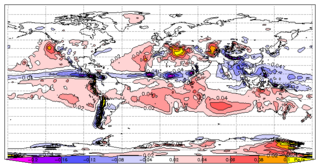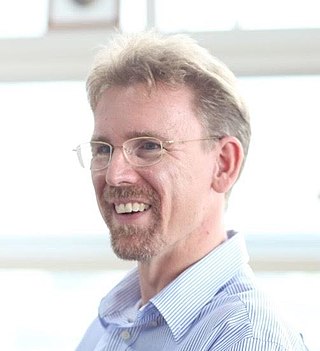Related Research Articles
The quasi-biennial oscillation (QBO) is a quasiperiodic oscillation of the equatorial zonal wind between easterlies and westerlies in the tropical stratosphere with a mean period of 28 to 29 months. The alternating wind regimes develop at the top of the lower stratosphere and propagate downwards at about 1 km (0.6 mi) per month until they are dissipated at the tropopause. Downward motion of the easterlies is usually more irregular than that of the westerlies. The amplitude of the easterly phase is about twice as strong as that of the westerly phase. At the top of the vertical QBO domain, easterlies dominate, while at the bottom, westerlies are more likely to be found. At the 30 mb level, with regards to monthly mean zonal winds, the strongest recorded easterly was 29.55 m/s in November 2005, while the strongest recorded westerly was only 15.62 m/s in June 1995.
The Carl-Gustaf Rossby Research Medal is the highest award for atmospheric science of the American Meteorological Society. It is presented to individual scientists, who receive a medal. Named in honor of meteorology and oceanography pioneer Carl-Gustaf Rossby, who was also its second (1953) recipient.
El Niño–Southern Oscillation (ENSO) is an irregular periodic variation in winds and sea surface temperatures over the tropical eastern Pacific Ocean, affecting the climate of much of the tropics and subtropics. The warming phase of the sea temperature is known as El Niño and the cooling phase as La Niña. The Southern Oscillation is the accompanying atmospheric component, coupled with the sea temperature change: El Niño is accompanied by high air surface pressure in the tropical western Pacific and La Niña with low air surface pressure there. The two periods last several months each and typically occur every few years with varying intensity per period.

In meteorology, a low-pressure area, low area or low is a region where the atmospheric pressure is lower than that of surrounding locations. Low-pressure areas are commonly associated with inclement weather, while high-pressure areas are associated with lighter winds and clear skies. Winds circle anti-clockwise around lows in the northern hemisphere, and clockwise in the southern hemisphere, due to opposing Coriolis forces. Low-pressure systems form under areas of wind divergence that occur in the upper levels of the atmosphere (aloft). The formation process of a low-pressure area is known as cyclogenesis. In meteorology, atmospheric divergence aloft occurs in two kinds of places:

The Madden–Julian oscillation (MJO) is the largest element of the intraseasonal variability in the tropical atmosphere. It was discovered in 1971 by Roland Madden and Paul Julian of the American National Center for Atmospheric Research (NCAR). It is a large-scale coupling between atmospheric circulation and tropical deep atmospheric convection. Unlike a standing pattern like the El Niño–Southern Oscillation (ENSO), the Madden–Julian oscillation is a traveling pattern that propagates eastward, at approximately 4 to 8 m/s, through the atmosphere above the warm parts of the Indian and Pacific oceans. This overall circulation pattern manifests itself most clearly as anomalous rainfall.

The Hadley cell, also known as the Hadley circulation, is a global-scale tropical atmospheric circulation that features air rising near the equator, flowing poleward near the tropopause at a height of 12–15 km (7.5–9.3 mi) above the Earth's surface, cooling and descending in the subtropics at around 25 degrees latitude, and then returning equatorward near the surface. It is a thermally direct circulation within the troposphere that emerges due to differences in insolation and heating between the tropics and the subtropics. On a yearly average, the circulation is characterized by a circulation cell on each side of the equator. The Southern Hemisphere Hadley cell is slightly stronger on average than its northern counterpart, extending slightly beyond the equator into the Northern Hemisphere. During the summer and winter months, the Hadley circulation is dominated by a single, cross-equatorial cell with air rising in the summer hemisphere and sinking in the winter hemisphere. Analogous circulations may occur in extraterrestrial atmospheres, such as on Venus and Mars.

Jagadish Shukla is an Indian meteorologist and Distinguished University Professor at George Mason University in the United States.
James C. McWilliams is a professor at the UCLA Institute of Geophysics and Planetary Physics and Department of Atmospheric and Oceanic Sciences.
Tapio Schneider is a climate scientist and a professor of environmental science and engineering at the California Institute of Technology. His research is focused on understanding how the turbulent dynamics of the atmosphere, from clouds to large-scale weather systems, shape Earth's climate. Ultimately, his goal is to develop a set of physical laws that govern climate.
Adam H. Sobel is a Professor of Applied Physics and Applied Mathematics and of Earth and Environmental Sciences at Columbia University. He directs its Initiative on Extreme Weather and Climate. His research area is meteorology with a focus on atmospheric and climate dynamics, tropical meteorology, and extreme weather.
Marilyn N. Raphael is a Trinidadian climatologist, best known for her work on climate change and variability in the high latitude southern hemisphere. She is a professor and former chair of the Department of Geography at UCLA, has authored an award-winning text, and sits in leadership positions on a number of international polar research initiatives.

Bhupendra Nath Goswami is an Indian meteorologist, climatologist, a former director of the Indian Institute of Tropical Meteorology (IITM). and a Pisharoty Chair Professor at the Indian Institute of Science Education and Research. He is known for his researches on the Indian monsoon dynamics and is an elected fellow of all the three major Indian science academies viz. Indian National Science Academy, Indian Academy of Sciences, and the National Academy of Sciences, India as well as The World Academy of Sciences. The Council of Scientific and Industrial Research, the apex agency of the Government of India for scientific research, awarded him the Shanti Swarup Bhatnagar Prize for Science and Technology, one of the highest Indian science awards for his contributions to Earth, Atmosphere, Ocean and Planetary Sciences in 1995.

Axel Timmermann is a German climate physicist and oceanographer with an interest in climate dynamics, human migration, dynamical systems' analysis, ice-sheet modeling and sea level. He served a co-author of the IPCC Third Assessment Report and a lead author of IPCC Fifth Assessment Report. His research has been cited over 18,000 times and has an h-index of 70 and i10-index of 161. In 2017, he became a Distinguished Professor at Pusan National University and the founding Director of the Institute for Basic Science Center for Climate Physics. In December 2018, the Center began to utilize a 1.43-petaflop Cray XC50 supercomputer, named Aleph, for climate physics research.
Amy C. Clement is an atmospheric and marine scientist studying and modeling global climate change at the University of Miami's Rosenstiel School of Marine and Atmospheric Science.

Little Ice Age volcanism refers to the massive volcanic activities during the Little Ice Age. Scientists suggested a hypothesis that volcanism was the major driving force of the global cooling among the other natural factors, i.e. the sunspot activities by orbital forcing and greenhouse gas. The Past Global Change (PAGES), a registered paleo-science association for scientific research and networking on past global changes in the University of Bern, Switzerland, suggested that from 1630 to 1850, a total of 16 major eruptions and cooling events had taken place. When a volcano erupts, ashes burst out of the vent together with magma and forms a cloud in the atmosphere. The ashes act as an isolating layer that block out a proportion of solar radiation, causing global cooling. The global cooling effect impacts ocean currents, atmospheric circulation and cause social impacts such as drought and famine. Wars and rebellions were therefore triggered worldwide in the Little Ice Age. It was suggested that the crisis on Ottoman Empire and Ming-Qing Transition in China were typical examples that closely correlated with Little Ice Age.

William Ka Ming Lau is a senior scientist at the Earth System Science Interdisciplinary Center, a research center at the University of Maryland and an Adjunct Professor of the Department of Atmospheric and Oceanic Sciences at the University of Maryland. A physicist by training, his research spans over 4 decades covering a wide range of topics in climate dynamics, tropical meteorology, ocean-atmosphere coupling, aerosol-water cycle interactions, and climate variability and change. Lau conducted pioneering research on atmospheric teleconnection, and the global monsoon climate system. He discovered the aerosol-monsoon regional feedback mechanism, i.e., the Elevated Heat Pump (EHP) effect that strongly modulate climate change in Asian monsoon regions. He was the senior author of a popular research reference book, “Intraseasonal Variability in the Atmosphere-Ocean Climate System”. As of November 2020, he has coauthored 297 refereed papers, with total citation = 33,932, h-index=101.
Ocean dynamical thermostat is a physical mechanism through which changes in the mean radiative forcing influence the gradients of sea surface temperatures in the Pacific Ocean and the strength of the Walker circulation. Increased radiative forcing (warming) is more effective in the western Pacific than in the eastern where the upwelling of cold water masses damps the temperature change. This increases the east-west temperature gradient and strengthens the Walker circulation. Decreased radiative forcing (cooling) has the opposite effect.
Bette Otto-Bliesner is an earth scientist known for her modeling of Earth's past climate and its changes over different geological eras.
Rodwell–Hoskins mechanism is a hypothesis about a climatic teleconnection between the Indian/Asian summer monsoon and the climate of the Mediterranean. It stipulates that ascending air in the monsoon region induces atmospheric circulation features named Rossby waves that expand westward and interact with the mean westerly winds of the midlatitudes, eventually inducing descent of the air. Descending air warms and its humidity decreases, thus resulting in a drier climate during the summer months. The interaction of this atmospheric flow with topography further modifies the effect.
Elizabeth A. Barnes is an American climate scientist. Barnes is best known for her work and expertise on the use of statistical methods to understand the variability of Earth's short- and long-term climate. Her work is characterized by an integration of both physics and computer science approaches. She is a Fellow of the American Geophysical Union.
References
- ↑ Tapio Schneider; Bordoni, Simona (August 2008). "Monsoons as eddy-mediated regime transitions of the tropical overturning circulation". Nature Geoscience. 1 (8): 515–519. Bibcode:2008NatGe...1..515B. doi:10.1038/ngeo248. ISSN 1752-0908.
- ↑ Pascale, Salvatore; Boos, William R.; Bordoni, Simona; Delworth, Thomas L.; Sarah B. Kapnick; Murakami, Hiroyuki; Vecchi, Gabriel A.; Zhang, Wei (November 2017). "Weakening of the North American monsoon with global warming" (PDF). Nature Climate Change. 7 (11): 806–812. Bibcode:2017NatCC...7..806P. doi:10.1038/nclimate3412. hdl:11572/244972. ISSN 1758-6798.
- ↑ Bordoni, Simona; Ciesielski, Paul E.; Johnson, Richard H.; McNoldy, Brian D.; Stevens, Bjorn (2004). "The low-level circulation of the North American Monsoon as revealed by QuikSCAT". Geophysical Research Letters. 31 (10): n/a. Bibcode:2004GeoRL..3110109B. doi:10.1029/2004GL020009. hdl: 11858/00-001M-0000-000E-BADA-B . ISSN 1944-8007. S2CID 603476.
- ↑ "Simona Bordoni Research Group at Caltech". web.gps.caltech.edu. Retrieved 2020-03-07.
- ↑ "ISSNAF AWARD LAUREATE - ISSNAF - Italian Scientists and Scholars in North America Foundation". www.issnaf.org. Retrieved 2019-04-12.
- ↑ "Bordoni Receives 2009 James R. Holton Junior Scientist Award". Honors Program. Retrieved 2019-04-12.